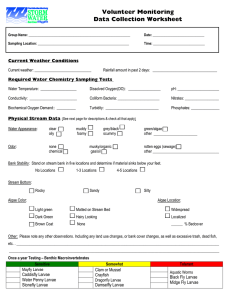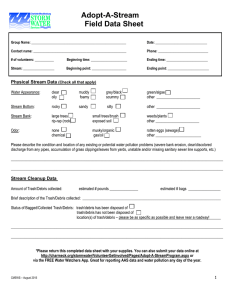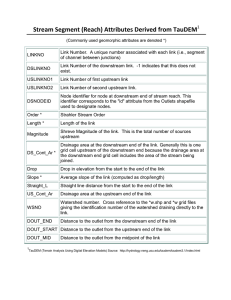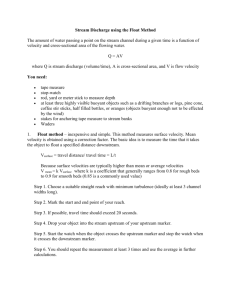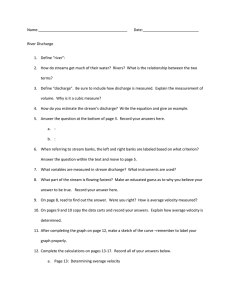Volunteer Monitoring Initial Data Collection Worksheet
advertisement
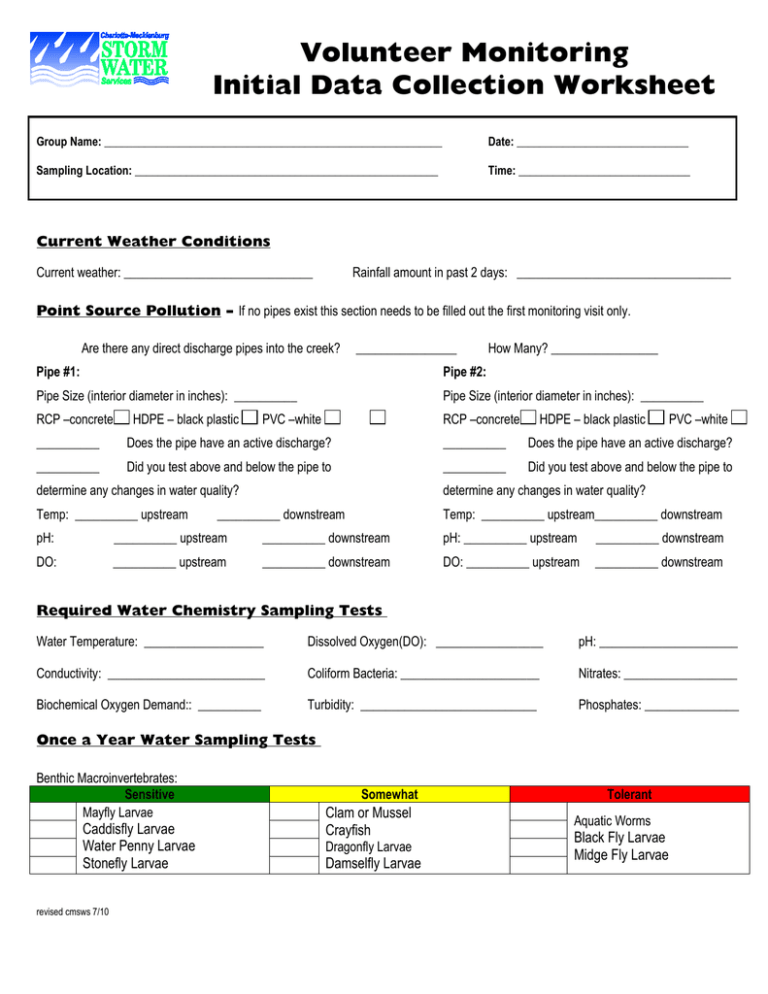
Volunteer Monitoring Initial Data Collection Worksheet Group Name: ___________________________________________________________ Date: ______________________________ Sampling Location: _____________________________________________________ Time: ______________________________ Current Weather Conditions Current weather: ______________________________ Rainfall amount in past 2 days: __________________________________ Point Source Pollution – If no pipes exist this section needs to be filled out the first monitoring visit only. Are there any direct discharge pipes into the creek? ________________ How Many? _________________ Pipe #1: Pipe #2: Pipe Size (interior diameter in inches): __________ Pipe Size (interior diameter in inches): __________ RCP –concrete RCP –concrete HDPE – black plastic PVC –white HDPE – black plastic PVC –white __________ Does the pipe have an active discharge? __________ Does the pipe have an active discharge? __________ Did you test above and below the pipe to __________ Did you test above and below the pipe to determine any changes in water quality? determine any changes in water quality? Temp: __________ upstream Temp: __________ upstream__________ downstream __________ downstream pH: __________ upstream __________ downstream pH: __________ upstream __________ downstream DO: __________ upstream __________ downstream DO: __________ upstream __________ downstream Required Water Chemistry Sampling Tests Water Temperature: ___________________ Dissolved Oxygen(DO): _________________ pH: ______________________ Conductivity: _________________________ Coliform Bacteria: ______________________ Nitrates: __________________ Biochemical Oxygen Demand:: __________ Turbidity: ____________________________ Phosphates: _______________ Once a Year Water Sampling Tests Benthic Macroinvertebrates: Sensitive Mayfly Larvae Caddisfly Larvae Water Penny Larvae Stonefly Larvae revised cmsws 7/10 Somewhat Clam or Mussel Crayfish Dragonfly Larvae Damselfly Larvae Tolerant Aquatic Worms Black Fly Larvae Midge Fly Larvae Physical Stream Data (See next page for descriptions & check all that apply) Water Appearance: clear oily muddy foamy Odor: none chemical grey/black scummy musky/organic gas/oil green/algae other _______________________ rotten eggs (sewage) other ___________________________________ Bank Cover: Look at the stream bank on both sides and determine % of plant cover in several spots. (mark left or right bank looking downstream) Good (70-100% of bank soil covered by plants) right bank left bank Fair (30-70% of bank soil covered by plants) right bank left bank Poor (0-30% of bank soil covered by plants) right bank left bank No change since last visit right bank left bank Bank Stability: Stand on stream bank in five locations and determine if material sinks below your feet. No Locations 1-3 Locations 4-5 Locations Stream Bottom: Rocky Sandy Silty Algae Color: Algae Location: Light green Matted on Stream Bed Widespread Dark Green Hairy Looking Localized Brown Coat None ______ % Bedcover Land Use: Check all that apply to your stream reach Stores/Commercial Factories/Industrial Farm Fields (cows/horses) Forest Residential Agriculture (crops) Construction Golf Course/Playing Field No change since last visit Other: Please note any other observations. i.e. excessive trash, dead fish, etc. ________________________________________________ _______________________________________________________________________________________________________________ Please return data collection worksheet to Volunteer Coordinator via: Email: erin.oliverio@mecklenburgcountync.gov Mail: Mecklenburg County Water Quality Program 700 N. Tryon Street, Suite 205, Charlotte, NC 28202 fax: 704-336-4391 Stream Survey Category Descriptions Use these descriptions to help fill out the field data sheet Water Appearance Clear The bottom of the stream can be seen without any obstruction from sediment, suspended matter, floating matter, or odd colors. Muddy brown Often associated with recent rain events or construction site runoff/discharge. Milky Whitish discoloration often accompanied by white cottony masses on streambed (sewage fungus) and a sewage odor. Grey/Black Color also associated with sewage discharge, often indicating a large discharge that has been occurring for an extended period. Green/Algae Water column is green, indicating nutrient enrichment (small to moderate amount of algal growth is good/normal). Oily Multi-color sheen on water surface. If surface is disturbed and sheen breaks apart in blocks, this may be iron bacteria which is natural. If it stays together and is accompanied by fuel odor, waste motor oil or fuel discharge may be present. Foamy Surface bubbles or formation of bubbles when water is disturbed (small amount of bubbles is normal). Soapy discharge may be present. Scummy A film of yellow-brown material on water’s surface may be pollen. Substrate Type Rocky Sandy Silty Odor Musky Bottom covered with many large rocks and gravel-sized stones. Bottom covered with coarse to fine sand. Bottom covered with particles smaller than sand, often giving the bottom a soft feeling composed of organic materials and sediment. Natural areas near streams often have a musky smell due to the decay of organic material (leaves, logs, plants). Rotten Eggs Stream smells like rotten eggs, possibly indicating sewage. The odor is created when anaerobic bacteria break down sewage and give off hydrogen sulfide gas. Gas/Oil Indication that waste motor oil or fuel has been discharged to the stream (look for visible signs of discharge). Chemical Indicates discharge of industrial waste or other source of chemical pollutants.
